Dispersion forces are mainly responsible for hydrogen bonding interactions.
False
Temporary dipoles are mainly responsible for hydrogen bonding interactions.
False
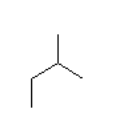
What is the main intermolecular force with the following compound?
Three line zigzag with line off 2nd point.
Van der Waal

What is the main intermolecular force with the following compound?
Four line zigzag with NH2 coming off first point.
Hydrogen bonding
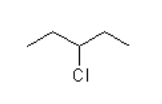
What is the main intermolecular force with the following compound?
Five line zigzag with Cl off 3rd point.
Dipole-dipole

What is the main intermolecular force with the following compound?
Zigzag with 6 lines.
Van der Waal
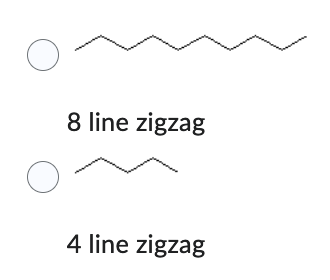
Which compound has the lower boiling point?
4 line zigzag
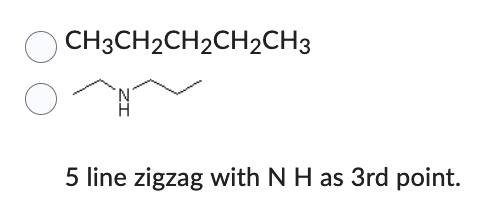
Which compound has the higher solubility in hexane (C6H14) ?
CH3CH2CH2CH2CH3
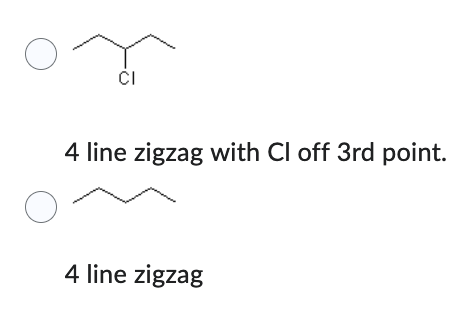
Which compound has the higher solubility in water?
4 line zigzag with Cl off 3rd point.
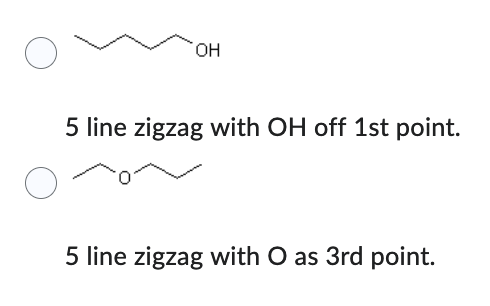
Which compound has the lower boiling point?
5 line zigzag with O as 3rd point.
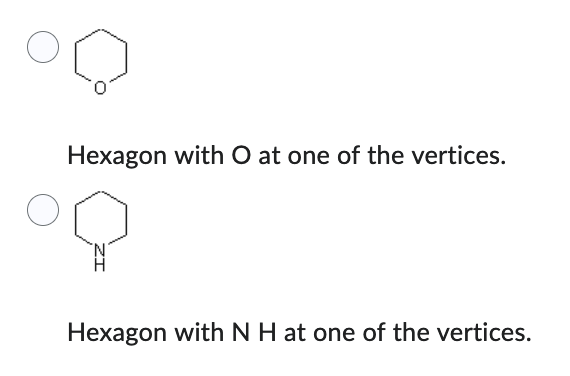
Which compound has the higher boiling point?
Hexagon with N H at one of the vertices.
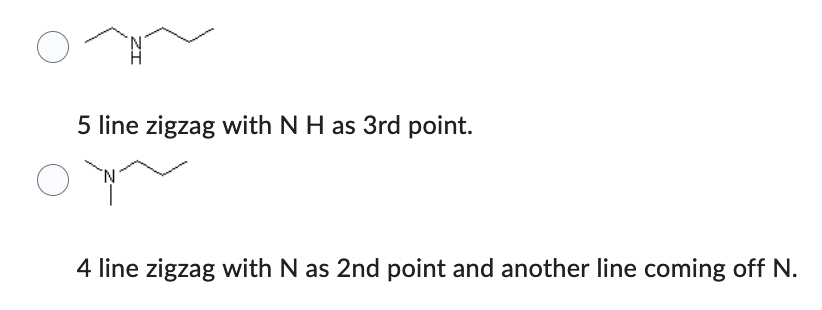
Which compound has the lower boiling point?
4 line zigzag with N as 2nd point and another line coming off N.
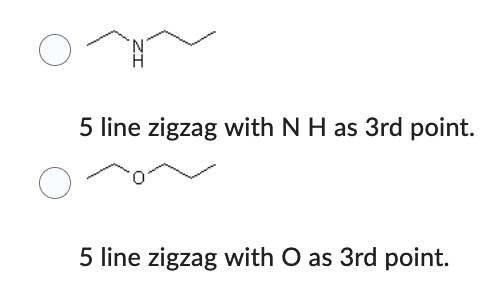
Which compound has the higher solubility in water?
5 line zigzag with N H as 3rd point.
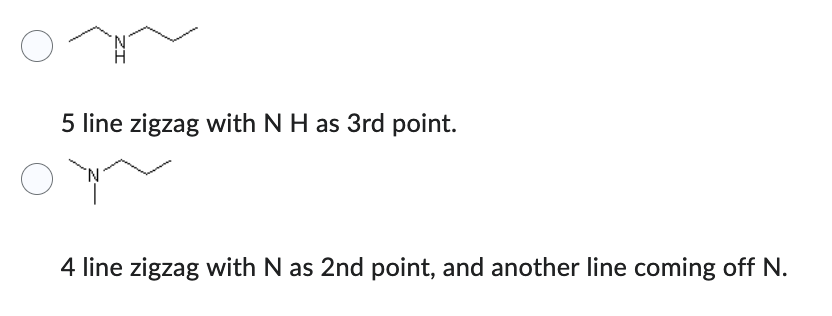
Which compound has the higher boiling point?
5 line zigzag with N H as 3rd point.
An unknown liquid has a heat of vaporization of 6.14 kJ/mole. If the vapor pressure of this liquid at -196 degrees C is 90 torr, what is the normal boiling point of this liquid in degrees C? HINT: Normal boiling point occurs when the vapor pressure of the liquid is the same as atmospheric pressure (1 atm or 760 mm Hg).
P1 = 760 torr
P2 = 90 torr
T1 = ?
T2 = -196 degrees C + 273 = 77 K
delta H = 6.14 kJ/mole x (1000 J / 1 kJ) = 6,140 J/mole
R = 8.314 K/J/mole
ln (P2 / P1) = - (delta H / R) x (1/T2 - 1/T1)
ln (90 / 760) = - (delta H / R) x (1/T2 - 1/T1)
= 99 degrees C
WRONG, ANSWER IS: -174 degrees C
How much heat is released when 13.74 grams of a gas is cooled from a temperature of 120.7°C to a solid at -19.4°C? If the process is exothermic be sure to include the proper sign with your answer.
Assume the molar mass of the sample is 21.95 grams/mole
Melting point: 2.9°C
Boiling point: 75.6°C
Specific heat of the solid: 1.21 J/g°C
Specific heat of liquid: 4.69 J/g°C
Specific heat of gas: 1.28 J/g°C
Enthalpy of fusion: 4.96 kJ/mol
Enthalpy of vaporization: 21.84 kJ/mol
Report your answer in kJ
Do not type units with your answer.
NOT FINISHED BUT ANSWER SHOULD BE: -22.62
Moles of substance = mass / molar mass = 13.74 g / 21.95 g/mol = 0.625968 mol
Q1 (solid, ice) = 13.74 g x 1.21 J/g°C x (2.9°C-(-19.4°C)) =
Q2 (fusion, ice and water) = 4.96 kJ/mol x 0.625968 mol = kJ
Q3 (liquid, water) = 13.74 g x 4.69 J/g°C x (75.6°C-2.9°C) =
Q4 (vaporization, water and steam) = 21.84 kJ/mol x 0.625968 mol = kJ
Q5 (gas, steam) = 13.74 g x 1.28 J/g°C x (120.7°C-75.6°C) =
How much heat is released when 12.48 grams of a liquid is cooled from a temperature of 69.9°C to a solid at -10.4°C? If the process is exothermic be sure to include the proper sign with your answer.
Assume the molar mass of the sample is 16.61 grams/mole
Melting point: 3.9°C
Boiling point: 99.7°C
Specific heat of the solid: 1.25 J/g°C
Specific heat of liquid: 2.22 J/g°C
Specific heat of gas: 1.47 J/g°C
Enthalpy of fusion: 5.10 kJ/mol
Enthalpy of vaporization: 28.08 kJ/mol
Report your answer in kJ
Do not type units with your answer.
NOT FINISHED BUT ANSWER SHOULD BE: -5.88
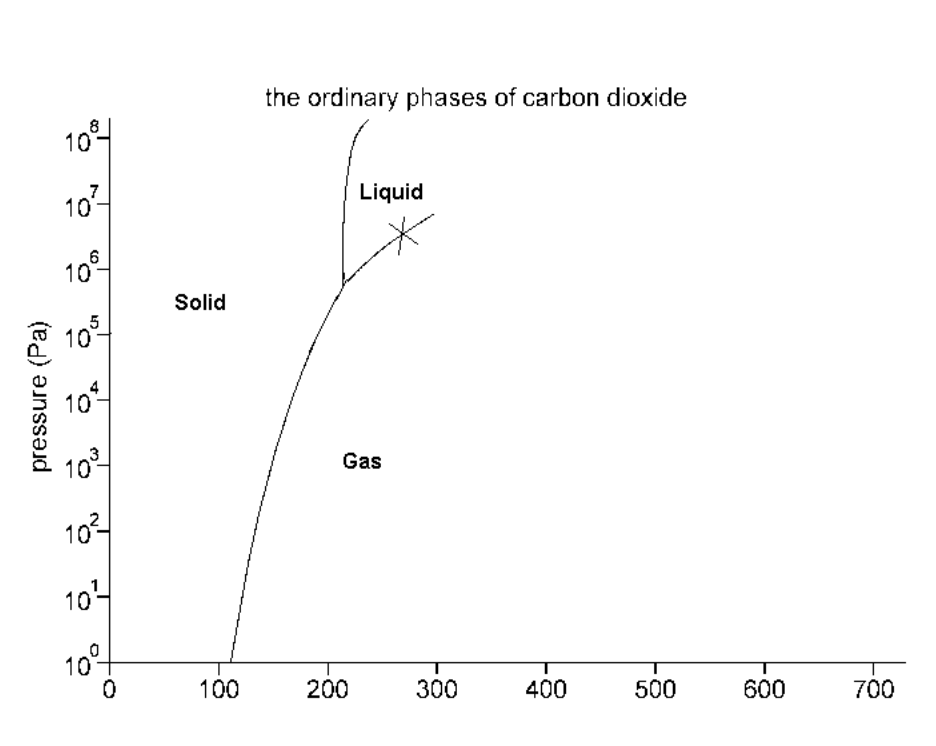
Consider the phase diagram below:
The critical pressure is:
Screen reader description: The Ordinary Phases of Carbon Dioxide. Pressure (Pa) 10 to the power of 0 to 10 up to 10 to the power of 8 on Y-axis. Temperature in Kelvins 0 to 700 on X-axis. Curved line up from 105 K at 10 to the power of 0 Pa up to 200 K and 10 to the power of 6 Pa. The line forks here. There is an almost vertical line up to 10 to the power of 8 Pa, and a line that goes diagonally up and to the right to 325 K and 10 to the power of 7 Pa. To the left of the fork is "Solid". To the right of the fork is "Gas". In between the lines of the fork is "Liquid". End of image.
107 Pa
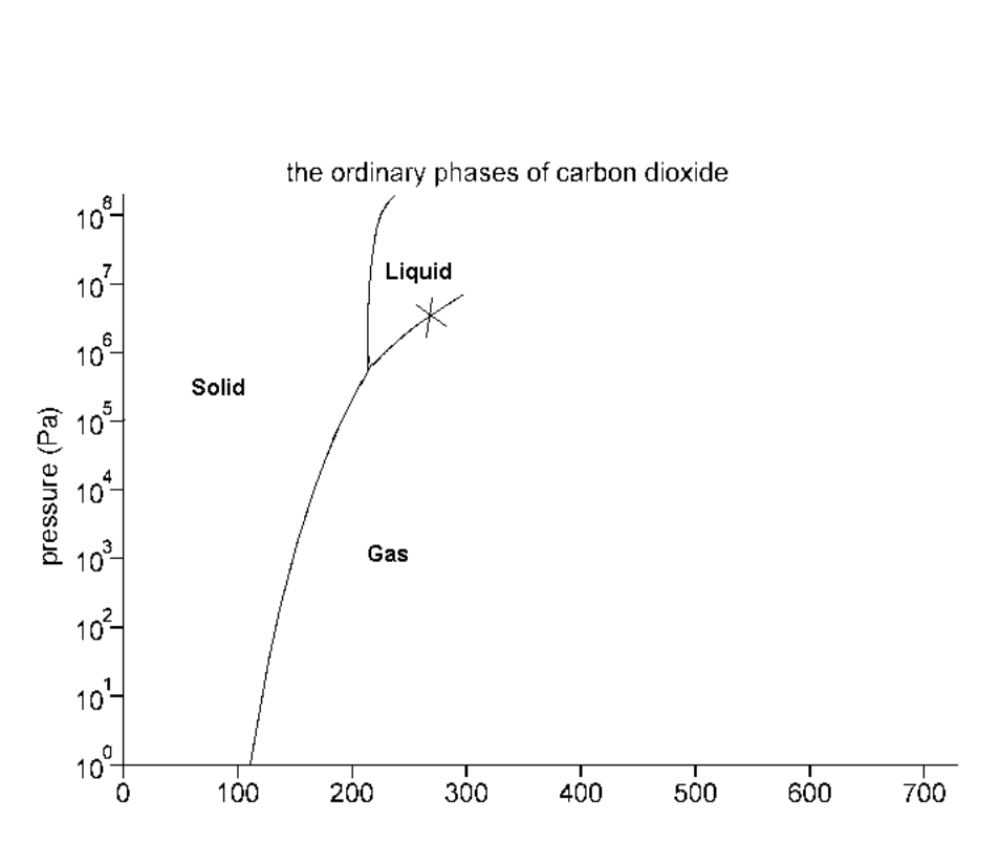
Consider the phase diagram below:
The pressure is increased slowly from 10 Pa at 200 K. Which of these best describes what is observed?
Screen reader description: The Ordinary Phases of Carbon Dioxide. Pressure (Pa) 10 to the power of 0 to 10 up to 10 to the power of 8 on Y-axis. Temperature in Kelvins 0 to 700 on X-axis. Curved line up from 105 K at 10 to the power of 0 Pa up to 200 K and 10 to the power of 6 Pa. The line forks here. There is an almost vertical line up to 10 to the power of 8 Pa, and a line that goes diagonally up and to the right to 325 K and 10 to the power of 7 Pa. To the left of the fork is "Solid". To the right of the fork is "Gas". In between the lines of the fork is "Liquid". End of image.
It starts out as a gas, then becomes a solid.
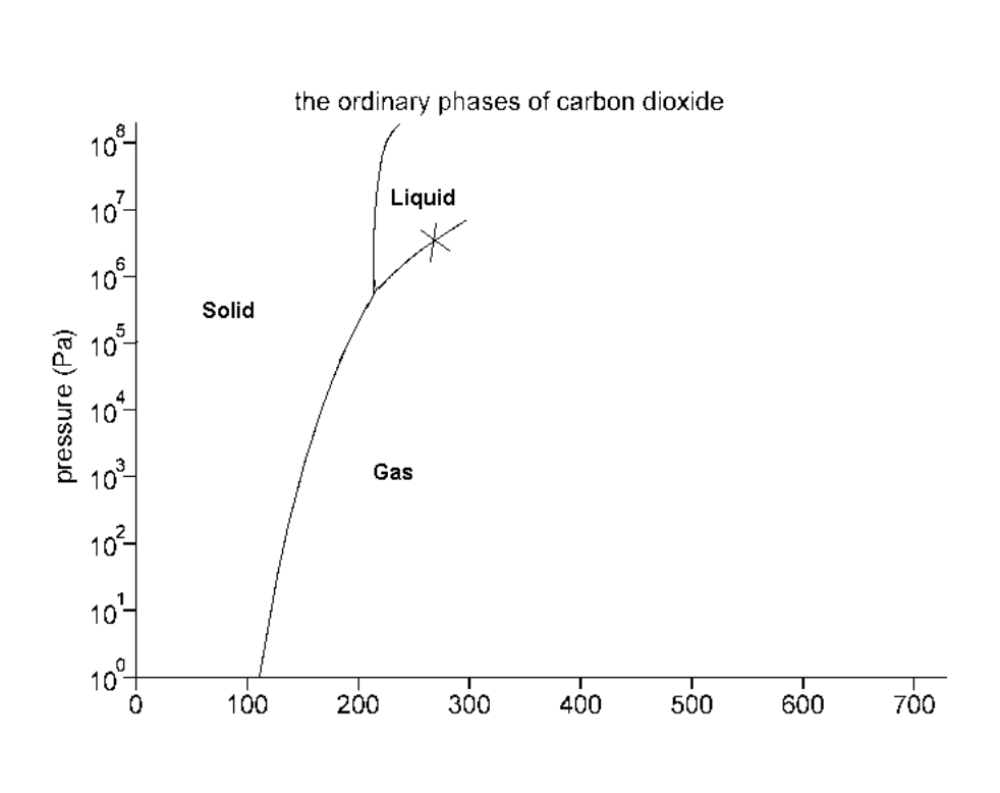
Consider the phase diagram below:
What phase(s) is/are present at 10000000 Pa and 250 K?
Screen reader description: The Ordinary Phases of Carbon Dioxide. Pressure (Pa) 10 to the power of 0 to 10 up to 10 to the power of 8 on Y-axis. Temperature in Kelvins 0 to 700 on X-axis. Curved line up from 105 K at 10 to the power of 0 Pa up to 200 K and 10 to the power of 6 Pa. The line forks here. There is an almost vertical line up to 10 to the power of 8 Pa, and a line that goes diagonally up and to the right to 325 K and 10 to the power of 7 Pa. To the left of the fork is "Solid". To the right of the fork is "Gas". In between the lines of the fork is "Liquid". End of image.
Liquid
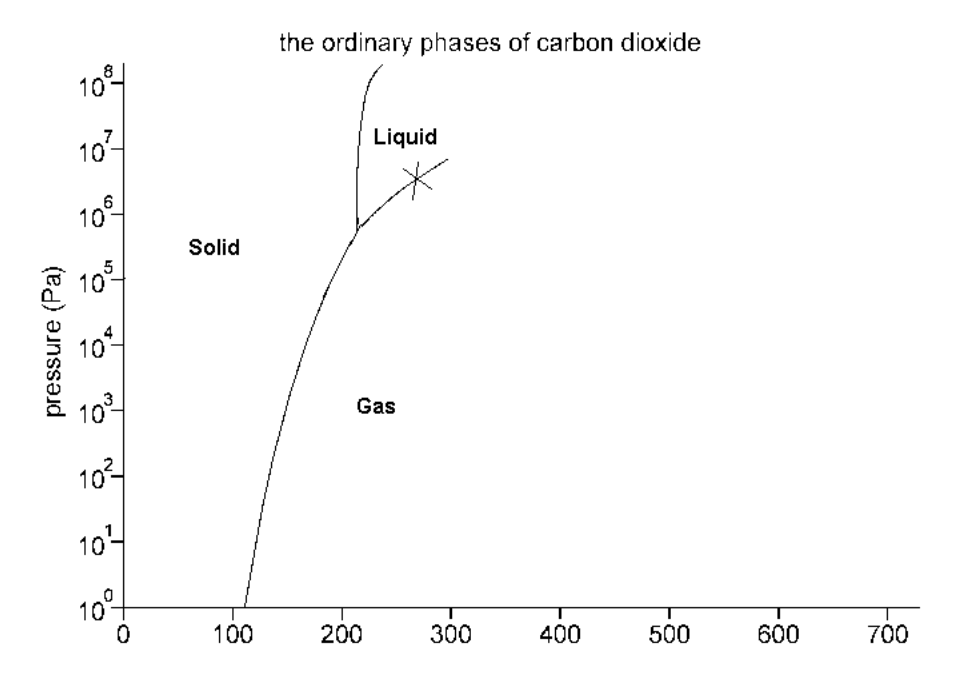
Consider the phase diagram below:
What phase(s) is/are present at 100000 Pa and 300 K?
Screen reader description: The Ordinary Phases of Carbon Dioxide. Pressure (Pa) 10 to the power of 0 to 10 up to 10 to the power of 8 on Y-axis. Temperature in Kelvins 0 to 700 on X-axis. Curved line up from 105 K at 10 to the power of 0 Pa up to 200 K and 10 to the power of 6 Pa. The line forks here. There is an almost vertical line up to 10 to the power of 8 Pa, and a line that goes diagonally up and to the right to 325 K and 10 to the power of 7 Pa. To the left of the fork is "Solid". To the right of the fork is "Gas". In between the lines of the fork is "Liquid". End of image.
Gas